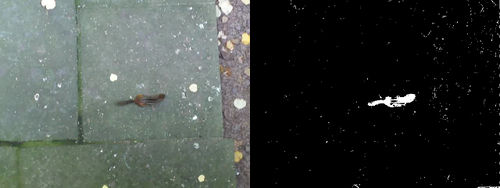Example Background Moving Camera
From BoofCV
Jump to navigationJump to search
In this example the objects which are moving relative to the background are highlighted in a binary image. While much slower than background modeling for static cameras, it can handle gradual camera motion when viewing environments that are approximately planar or being viewed for a distance. If the same videos were feed into a static camera background motion the entire image would be lit up as moving.
Example File:
Concepts:
- Motion Detection
- 2D Image Stitching
Related Examples:
Example Code
/**
* Example showing how to perform background modeling with a moving camera. Here the camera's motion is explicitly
* estimated using a motion model. That motion model is then used to distort the image and generate background.
* The net affect is a significant reduction in false positives around the objects of images in oscillating cameras
* and the ability to detect motion in moving scenes.
*
* @author Peter Abeles
*/
public class ExampleBackgroundRemovalMoving {
public static void main(String[] args) {
// Example with a moving camera. Highlights why motion estimation is sometimes required
String fileName = "../data/applet/tracking/chipmunk.mjpeg";
// Camera has a bit of jitter in it. Static kinda works but motion reduces false positives
// String fileName = "../data/applet/background/horse_jitter.mp4";
// Comment/Uncomment to switch input image type
ImageType imageType = ImageType.single(ImageFloat32.class);
// ImageType imageType = ImageType.il(3, InterleavedF32.class);
// ImageType imageType = ImageType.il(3, InterleavedU8.class);
// Configure the feature detector
ConfigGeneralDetector confDetector = new ConfigGeneralDetector();
confDetector.threshold = 10;
confDetector.maxFeatures = 300;
confDetector.radius = 6;
// Use a KLT tracker
PointTracker tracker = FactoryPointTracker.klt(new int[]{1, 2, 4, 8}, confDetector, 3,
ImageFloat32.class, null);
// This estimates the 2D image motion
ImageMotion2D<ImageFloat32,Homography2D_F64> motion2D =
FactoryMotion2D.createMotion2D(500, 0.5, 3, 100, 0.6, 0.5, false, tracker, new Homography2D_F64());
ConfigBackgroundBasic configBasic = new ConfigBackgroundBasic(30, 0.005f);
// Configuration for Gaussian model. Note that the threshold changes depending on the number of image bands
// 12 = gray scale and 40 = color
ConfigBackgroundGaussian configGaussian = new ConfigBackgroundGaussian(12,0.001f);
configGaussian.initialVariance = 64;
configGaussian.minimumDifference = 5;
// Comment/Uncomment to switch background mode
BackgroundModelMoving background =
FactoryBackgroundModel.movingBasic(configBasic, new PointTransformHomography_F32(), imageType);
// FactoryBackgroundModel.movingGaussian(configGaussian, new PointTransformHomography_F32(), imageType);
MediaManager media = DefaultMediaManager.INSTANCE;
SimpleImageSequence video = media.openVideo(fileName, background.getImageType());
//====== Initialize Images
// storage for segmented image. Background = 0, Foreground = 1
ImageUInt8 segmented = new ImageUInt8(video.getNextWidth(),video.getNextHeight());
// Grey scale image that's the input for motion estimation
ImageFloat32 grey = new ImageFloat32(segmented.width,segmented.height);
// coordinate frames
Homography2D_F32 firstToCurrent32 = new Homography2D_F32();
Homography2D_F32 homeToWorld = new Homography2D_F32();
homeToWorld.a13 = grey.width/2;
homeToWorld.a23 = grey.height/2;
// Create a background image twice the size of the input image. Tell it that the home is in the center
background.initialize(grey.width * 2, grey.height * 2, homeToWorld);
BufferedImage visualized = new BufferedImage(segmented.width,segmented.height,BufferedImage.TYPE_INT_RGB);
ImageGridPanel gui = new ImageGridPanel(1,2);
gui.setImages(visualized, visualized);
ShowImages.showWindow(gui, "Detections", true);
double fps = 0;
double alpha = 0.01; // smoothing factor for FPS
while( video.hasNext() ) {
ImageBase input = video.next();
long before = System.nanoTime();
GConvertImage.convert(input, grey);
if( !motion2D.process(grey) ) {
throw new RuntimeException("Should handle this scenario");
}
Homography2D_F64 firstToCurrent64 = motion2D.getFirstToCurrent();
UtilHomography.convert(firstToCurrent64, firstToCurrent32);
background.segment(firstToCurrent32, input, segmented);
background.updateBackground(firstToCurrent32,input);
long after = System.nanoTime();
fps = (1.0-alpha)*fps + alpha*(1.0/((after-before)/1e9));
VisualizeBinaryData.renderBinary(segmented,false,visualized);
gui.setImage(0, 0, (BufferedImage)video.getGuiImage());
gui.setImage(0, 1, visualized);
gui.repaint();
System.out.println("FPS = "+fps);
try {Thread.sleep(5);} catch (InterruptedException e) {}
}
}
}
